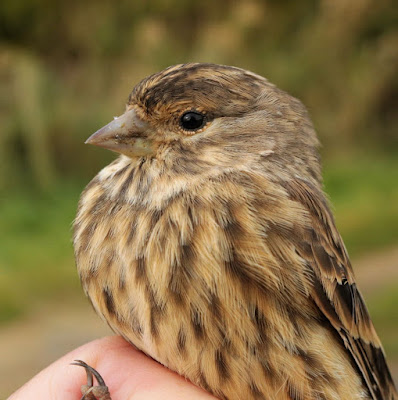The tail end of Hurricane Ian assured us that Monday would be the only morning for a spot of ringing. I was on the school run so met Andy and Will out Pilling way two hours after their start time of 0630. The weather forecast predicted the wind to steadily increase throughout the morning from a lowly 5 mph right through to 15mph, the latter a speed that would curtail the session early.
The boys had started well with Blackbirds, a rare Song Thrush, several Linnets and a new bird for the site in the shape of a tiny female Cetti’s Warbler.
The Cetti’s Warbler is a species still on the increase in this the Fylde plain. Further expansion may be difficult as potential sites get swallowed up by the creation of new build at the expense of green land as homo sapiens escape inland towns and cities for a healthier environment.
There was a strange looking male Blackbird that exhibited pale emarginations to much of its underside plumage, the like and extent of which I’d not seen before.
We continued in the same vein, interspersed with sightings of dashing Merlin, Peregrine and Sparrowhawk all looking for a slice of the action. Perhaps they were drawn in by the small flocks of Linnets that arrived, along with a Stonechat, several Meadow Pipits or the steady stream of Skylarks flying from North to South West.
By 1100 the wind became too strong and we packed in after 29 Birds caught - 1 Goldfinch, 1 Great-spotted Woodpecker, 1 Goldcrest, 1 Robin, 1 Blue Tit, 1 Song Thrush, 1 Cetti's Warbler, 2 Blackbird, 2 Wren, 18 Linnet.
We noted good numbers of Linnets around, c150-200, and would probably have caught more but for the increasing wind speed and a billowing net.
There were darker headed and longer winged Linnets, signs of Scottish birds leaving the highlands and islands in readiness to escape the first frosts and to spend winter in the relative warmth of the Irish Sea gulf stream.
There’s more soon on Another Bird Blog with a trip across North America. Don’t miss it.


































.jpg)











